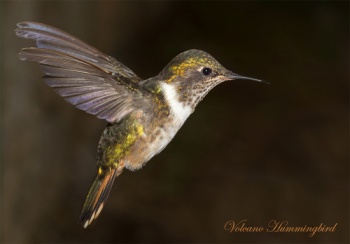- Selasphorus flammula
Identification
7.5cm
- Bronze-green upperparts
- White underparts
- Rufous-edged black outer tail feathers
- The flaring gorget is different according to the range; each is a subspecies. It is grey-purple in the Talamanca range, red in the Poas-Barva mountains and pink-purple in the Irazú-Turrialba area.
The female is similar, but her throat is white with dusky spots.
Young birds resemble the female but have buff fringes to the upperpart plumage.
Similar Species
Scintillant Hummingbird - the male is distiguishable by the orange gorget, but the female is almost identical. Look for a shorter section of rufous and brighter white tips on the Volcano's rectrices. The Volcano occurs at higher elevations, but in an area of range overlap, distinguishing the females can be very difficult in the field.
Distribution
South America: found only in Costa Rica and Panama
Taxonomy
Subspecies
Three subspecies are recognized for this species[1]:
- S. f. flammula: (Purple-throated)
- Costa Rica (Volcán Irazú and Volcán Turrialba)
- S. f. torridus: (Heliotrope-throated)
- Sierra de Talamanca (Costa Rica) and Volcán Barú (western Panama)
- S. f. simoni: (Rose-throated) - the male has a red gorget
- Costa Rica (Volcán Poás, Volcán Barba and Cerros de Escazú)
The subspecies simoni,has in the past, been considered a full species: Cerise-throated Hummingbird.
Habitat
Found 1800 meters or higher in elevation in Paramo habitat, brushland, in gardens and clearings.
Behaviour
Breeding
The female builds a cup shaped nest from plant down high in a scrub or on a root below a south or east facing bank. The 2 white eggs are incubated by the female for 15-19 days; the young fledge after another 20-26 days.
Diet
The diet includes nectar, taken from a variety of small flowers, including Salvia and Fuchsia, and species normally pollinated by insects. It also takes some small insects.
References
- Clements, JF. 2010. The Clements Checklist of Birds of the World. 6th ed., with updates to December 2010. Ithaca: Cornell Univ. Press. ISBN 978-0801445019. Spreadsheet available at http://www.birds.cornell.edu/clementschecklist/Clements%206.5.xls/view
- Wikipedia
Recommended Citation
- BirdForum Opus contributors. (2024) Volcano Hummingbird. In: BirdForum, the forum for wild birds and birding. Retrieved 24 April 2024 from https://www.birdforum.net/opus/Volcano_Hummingbird






